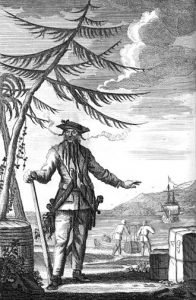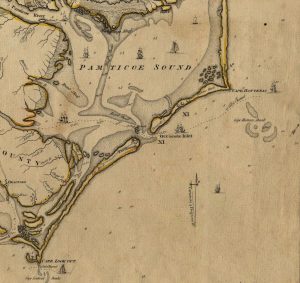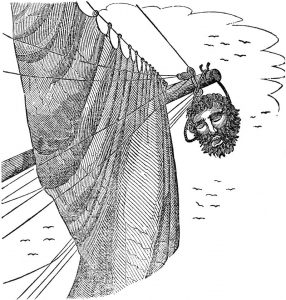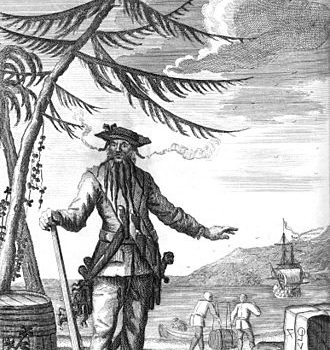
When talking about pirates, the nefarious 18th century character of Blackbeard almost always comes up. It seems his name is synonymous with tales of plundering ships and ruthless battles on the high seas. The nickname Blackbeard is rightfully earned by this legendary pirate. He was recognized easily by his signature long dangling thick black beard. But who was he really? Was he as fierce and wealthy as the tales lead us to believe? And might he have left any buried treasure behind for us to find? We’ll explore these questions.
It is widely agreed Blackbeard’s real name was Edward Teach. It is also often stated that he was born in Bristol, England, in the late 1600’s. But this is not as absolute as supposed, though. In the book, The Last Days of Blackbeard by Kevin Duffus, he writes,
“not anywhere among the voluminous records, including a 1698 Bristol census, nor millions of words written about the infamous bearded pirate, is there a single, conclusive, definitive shred of evidence that Edward Thatch/Teach came from Bristol.”
The main reason it is thought Blackbeard was born in Bristol is because of a highly popular book written by Charles Johnson in 1724. This book, The General History of the Pyrates, while extremely entertaining and filled with sensational biographies of numerous pirates, is where many of today’s fantastical ideas about pirates originate. Much of the information offered, however, can’t be proven as fact, and much has actually been realized to hold only partial truths and extreme exaggerations.
Funnily, it remains a mystery who even Charles Johnson, the author of this influential book, was. It seems he not only hid his real name for all time to know, but by taking countless liberties and using his wild imagination to expand upon the possible facts he may have known about pirates, he has hidden his facts amongst the semi-fictional work. It is for us to investigate which is which now. Fact or fiction?
To gain reliable information on Blackbeard then leaves researchers to scouring written historical records for Blackbeard’s name. Some of the first written accounts were when he was an active pirate. Nothing conclusive can be found on his early life. In Blackbeard’s Sunken Prize, by Wilde-Ramsing and Carnes-McNaughton, it is stated,
“The first mention of Thache, was as a pirate commander of an eight-gun sloop out of Jamaica in later 1716 sailing alongside another key pirate, Captain Benjamin Hornigold. Their early focus was ‘fishing’ for treasure on the Spanish ships lost off the coast of Florida in 1715, before they turned to all-out robbery of ships.”
Thatch’s name is also found in July of 1717. It is in a report gathered to access the trouble of pirates off the coast of Charleston, South Carolina. Blackbeard (Thatch (alternate spelling of Teach) is noted with a sloop, six guns, and about 70 men in the report. He had hit the pirate scene on his own by this time.
Blackbeard/Edward Teach, for all his notoriety, was only active as a pirate for a period of less than two years. It is assumed that he crossed the ocean (IF he was from Bristol) and became an ‘apprentice pirate’ under Benjamin Hornigold. Soon after, he became Captain of his own crew.

It is recorded he sailed the waters around the West Indies, and then up the Atlantic Coast, with a base on Ocracoke Island, North Carolina, at the end of his days. He captured many vessels and quickly rose as a threatening force on the ocean.
He’s famous for laying siege to the city of Charleston, SC in May 1718 (then known as Charles Town). Here it is recounted he plundered numerous ships over a course of a week, and at the end of his wreaking havoc, he held for ransom around 80 passengers aboard the Crowley. Many of these were affluent colonists, and although he had stripped them of all their valuables, he treated them well enough.
This has caused many to question Blackbeard’s alleged fierce and cruel manner, which has been written about by so many–their source often traced back to Charles Johnson’s questionable 1724 publication. His malicious reputation might be more of fiction than fact, for there isn’t any proof he ever killed for the fun of it. Factual historical records seem to suggest he avoided killing as much as possible.
For instance, the siege on Charleston ended rather peacefully. Blackbeard demanded only medicines for the return of passengers, which was granted. Colin Woodward writes, in The Republic of Pirates,
“They left Charleston with only one prize: a Spanish sloop they had taken off Florida. Blackbeard had paralyzed an entire colony for over a week but, for reasons unknown, was willing to settle for plunder worth less than £2,000.”
It is difficult to determine what ‘wealth’ had been accumulated by Blackbeard before his untimely demise. At the time, trade of goods, for other goods, like rum, was more the custom than exchanging coinage. However, after leaving Charleston aboard his famous ship, The Queen Anne’s Revenge, he betrayed members of his crew who later testified he took significant bounty with him.
The story goes that in June of 1718, Blackbeard’s main vessel, the famous Queen Anne’s Revenge, was lost on a sandbar off the North Carolina shore. The crew aboard the ship scurried for safety on other boats of the company. It is at this time, Blackbeard is known to have left most of his shipmates stranded, and sailed off with all the loot. Many of the pirates, who were later caught, testified to such during their own trials.
It is known Blackbeard did run off and went to Bath to ask for a pardon from Governor Eden. He received his pardon and took up residence in Bath, but not for long. There is record of his appearance in Philadelphia in August of 1718. Governor Keith of Philadelphia wanted Teach to be apprehended. The following was noted in one of the council meetings:
“Upon an informacon that one Teach, a noted Pirate, who has done the greatest mischief of any to this place, has been lurking for some days in and about this town, I have granted a Provincial warrant for his being apprehended…”
What Blackbeard’s business in the city of brotherly love is curious. However, an earlier account found, mentioning Blackbeard, hints he had a past there. It is as follows:
“Philadelphia, Oct 24. (1717) Arrives Linsey from Antigua, Codd from Liverpool and Dublin with 150 passengers, many whereof were servants. He was taken about 12 days since off our capes by a pirate sloop called the Revenge, of 12 guns, 150 men, commanded by one Teach, who formerly sail’d mate out of this port.”
Philadelphia was not a strange town to Blackbeard. How and when he ‘sail’d mate out of this port’ is a mystery, but it proves there is an earlier history to Blackbeard that is unknown. One that includes Philadelphia, sailing in and out of the Delaware Bay, and to the vast Atlantic.
Blackbeard returned to Bath in the fall of 1718, but not before ignoring his pardon and becoming Pirate again on his way back. His plundering ways would catch up with him this time though. The authorities had enough and went on the hunt for Blackbeard. They found him at Ocracoke Inlet.

On Friday, November 22, 1718, Lieutenant Maynard of the Royal Navy attacked Blackbeard and his small crew on the Revenge. Blackbeard was outnumbered and was killed by being decapitated. Most of his shipmates found a similar fate off the Ocracoke Inlet as well.
The Scourge of the Seas by Angus Konstam reports, “Maynard sailed to Bath Towne, repaired his ships and sailed back to Williamsburg, dangling Teach’s head for the bowspirit of his sloop.”
It is partly from this gruesome image of Blackbeard’s severed head that the name of Blackbeard lives on, and why the Ghost of Blackbeard is said to haunt the waterways of North Carolina.
But with his death, the question remained, had Blackbeard buried any treasure during his life? There was nothing of worth to be found on the Revenge after his tragic fate or anywhere else.
With the discovery of the Queen’s Anne Revenge in 1996, and its exploration, it can be confirmed there weren’t any chests of gold found under the sea either. So where is the loot he sailed off with after leaving the Queen’s Anne Revenge? His stranded crew had testified he had left with thousands of pounds sterling money.
While the most popular or favorite locations for Blackbeard’s buried treasure is Ocracoke Island, and the lands near those waterways, including Bath, the piece of information about Philadelphia shouldn’t be dismissed.
Had he buried some of his treasure on the land he owned in Bath, or had he taken some of his plunder to Philadelphia and either buried some there, or on lands along the way? Maybe all of these?
Numerous treasure seekers have longed to find the legendary Blackbeard’s believed buried gold, and have searched these areas to no avail. There isn’t any map or X that marks the spot. Or at least none of which have been found yet either.
The one treasure of Blackbeard’s that has been found, though, is the Queen’s Anne Revenge. The many artifacts brought back to the surface from its sinking in 1718 have told stories of Blackbeard and his crew.
The cannons, ship bells, navigational instruments, medical supplies, kitchen utensils, bottles, ceramics, and many other daily living items were recovered from Blackbeard’s one prize. They reveal how the pirates lived on board, and offer a glimpse into their lives.
For now, until Blackbeard’s hidden stashes are unearthed, if there are any, it is these treasures that will have to do.
Best of luck with all that you seek! Always Treasure the Adventure!
.


Ahhh old Edward is it ? and no one commits on this ?Okay how about a question then ?Is there by any chance a Masonic lodge in old Benjamin’s Town?
no wig there was not one there then but he may have went to the Tun Tavern , down on the water front …… hmmmm…….
There exists on old Maps of Virginia (Virginia Beach) underneath the “duck head”, a spot called Blackbeard’s Hill (also called by another name). What is the history of this spot, including if it is a true location of Teaches?